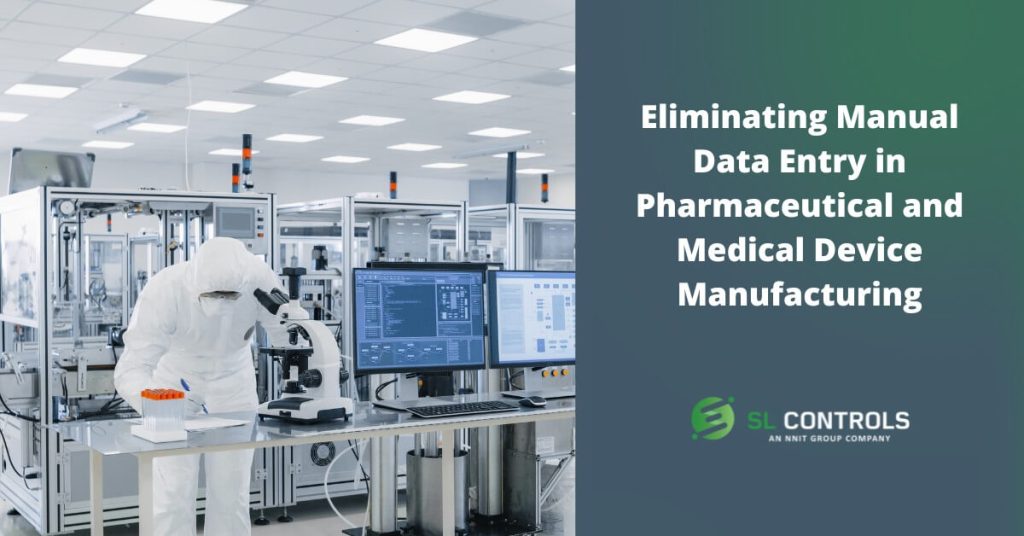Digitalising pharmaceutical and medical device manufacturing facilities is a high priority for companies in the life sciences sector. Achieving this priority involves developing fully integrated production lines while maintaining (and improving) compliance with GxP regulations. Eliminating manual data entry is an essential requirement to reach this level of digitalisation.
The rewards of creating the fully digitalised factory of the future are great – enhanced productivity, less reliance on increasingly difficult-to-find labour, and improved competitiveness, resilience, and profitability, to name a few.
However, the digitalised life sciences sector factory of the future requires full equipment and systems integration built on a foundation of integrated data.
Why Integrated Data is Essential
Manual data entry processes restrict pharma and MedTech manufacturing facilities from realising the full potential of advanced technologies such as digital twins and artificial intelligence (AI), i.e., technologies that rely on accurate, well-structured, real-time data.
Furthermore, the science behind innovations in the pharmaceutical and medical device industries is moving at pace, and production processes need to keep up. Personalised medicines such as cell and gene therapies are a good example, as the process of manufacturing personalised medicines is far too complex to manage with manual data entry.
Why Manual Data Entry is Not Suitable for the Digitalised Factory of the Future
Manually Entered Data is Inconsistent and Unstructured
A single piece of data can be recorded in a range of different ways. Dates and times are good examples, as there are many different ways of recording a date or time. This results in inconsistencies, and it is difficult to do anything with inconsistent or unstructured data beyond its raw existence.
Manually Entered Data is Prone to Human Error
Errors in manual data entry can occur for a range of different reasons. Staff might not be properly trained, for example, or mistakes can happen because of work pressures or workload spikes. Simple typos are another problem, and ambiguous or unclear data can cause issues.
Mistakes can also occur if record keeping is not contemporaneous, i.e., where systems are not updated at the time of recording the data. Any time lag between recording the data and entering it into the system increases the risk of error.
Manually Entered Data is Subject to Bias and Can Be Contested
Operator biases, either conscious or unconscious, can corrupt data that is recorded manually. This reality combined with the inevitability of human error means all manually entered data can be contested.
Manually Entered Data Creates Bottlenecks and Restricts Productivity
Manually entering data takes time, so it can create bottlenecks on production lines as well as in quality control processes. The potential for productivity improvements is also limited when operators have to spend time manually entering data.
Manually Entering Data is Labour Intensive
Manually entering data requires resources, plus it is not a task that can be considered value-adding.
Manually Entered Data Limits Real-Time Insights
When manual data entry processes are used, it is not possible to rely on the completeness or accuracy of real-time data.
Integrated Versus Automated Data
While the elimination of manual data entry is essential for pharma and MedTech manufacturers, it is also important to highlight the difference between automated data entry and integrated data.
With automated solutions, data is collected by devices and sensors in real time. This is significantly better than manual data entry, but it is an approach that is fragmented if the various systems and equipment, including legacy systems, are not integrated.
Therefore, integrated data goes further than automated data entry as it eliminates this fragmentation.
The Transition from Manual Data to Integrated data
The transition from manual data to integrated data involves integrating equipment and systems across the organisation and beyond. This includes operational technology on the production line as well as IT systems across other departments and business units. It often also involves integration across the supply chain.
It is important that manual data entry is eliminated entirely as any manually entered data that is merged with integrated data will corrupt the wider data stream.
However, the move to fully integrated data cannot typically occur overnight. A staged process is more realistic, but controls and processes can be put in place to minimise manual data entry risks. For example, instead of an operator typing an entry into a field, they should select a pre-defined option in a drop-down.
Advances in technologies and the capabilities of modern MES platforms are presenting significant opportunities for manufacturers in the life sciences sector – opportunities to modernise, improve, and innovate. The elimination of manual data entry and replacing it with integrated data is central to success.





